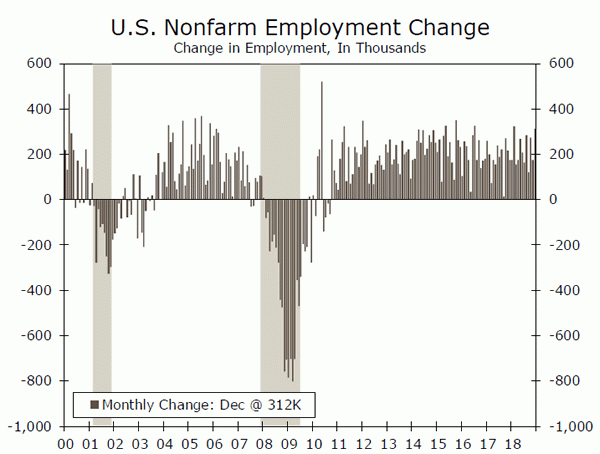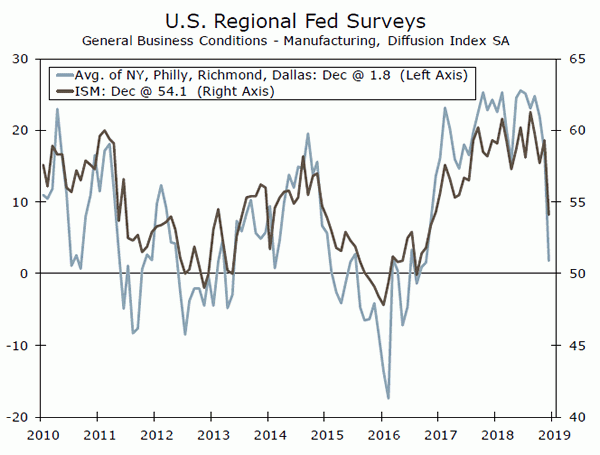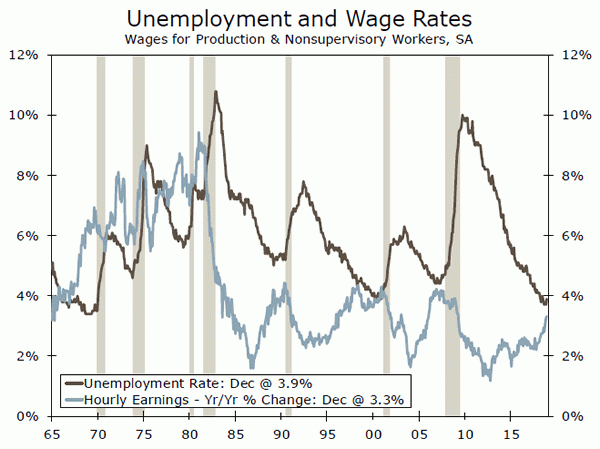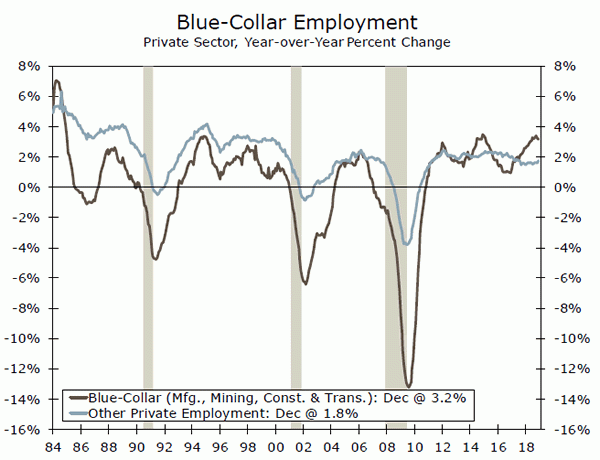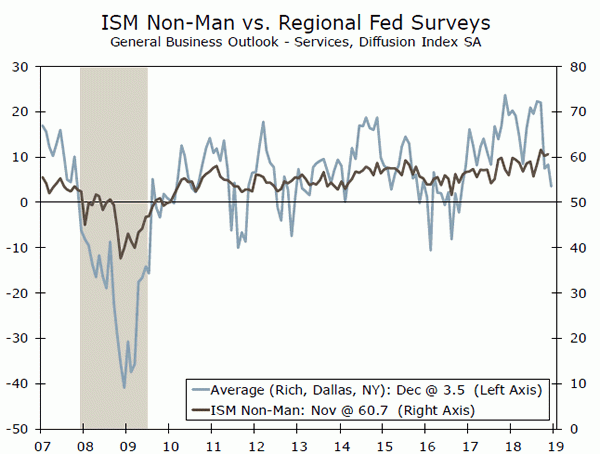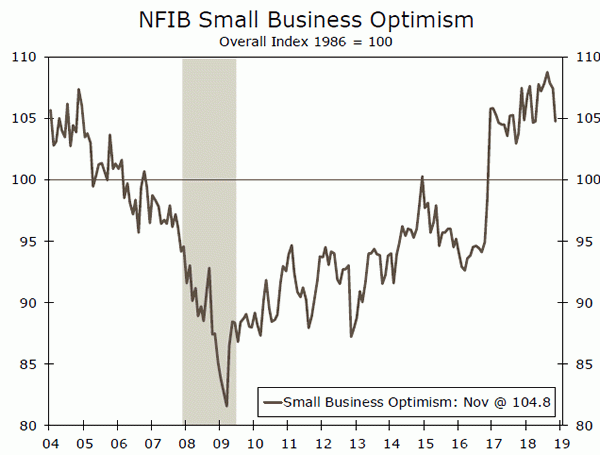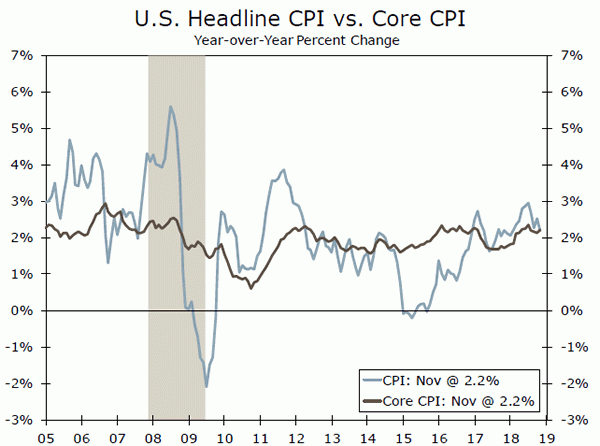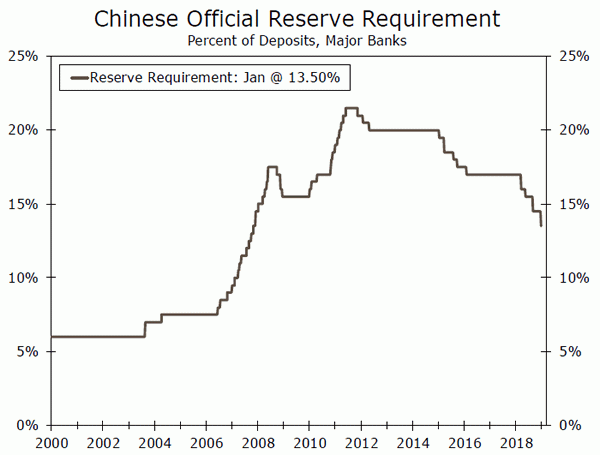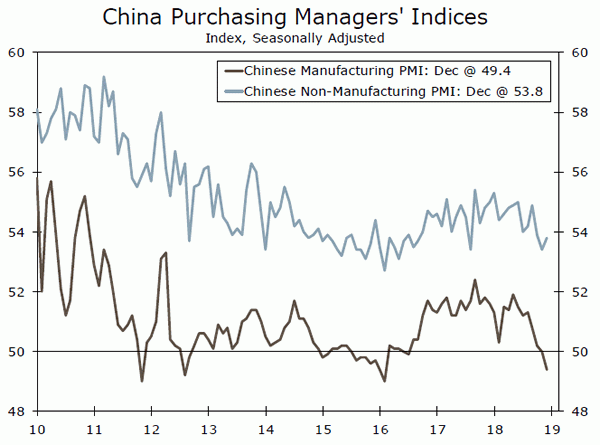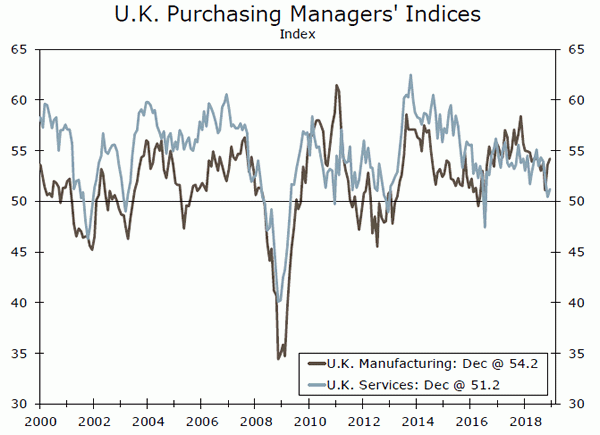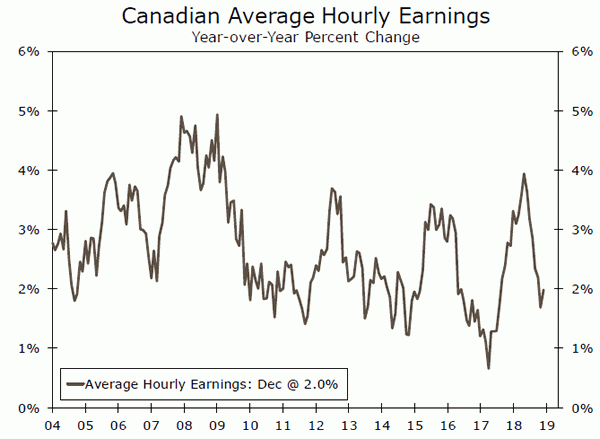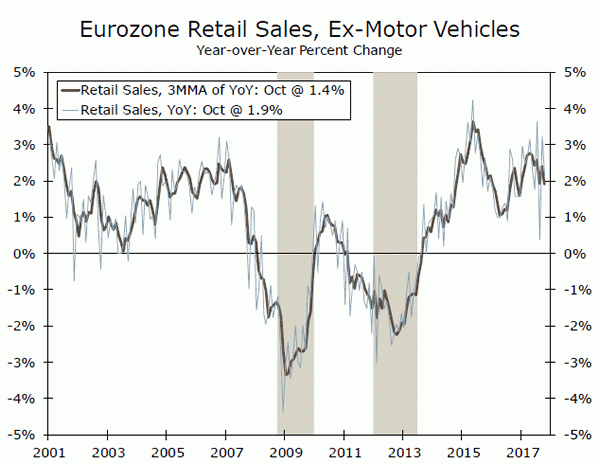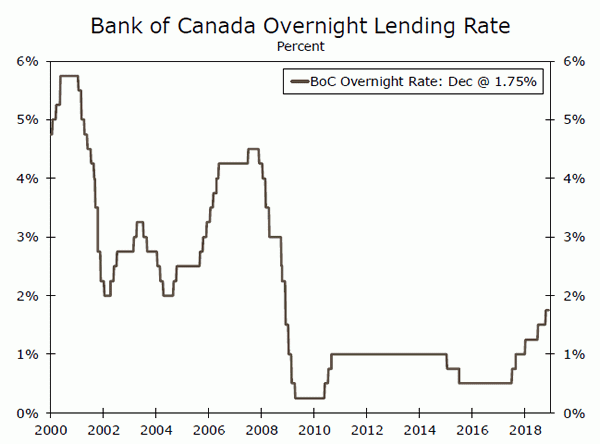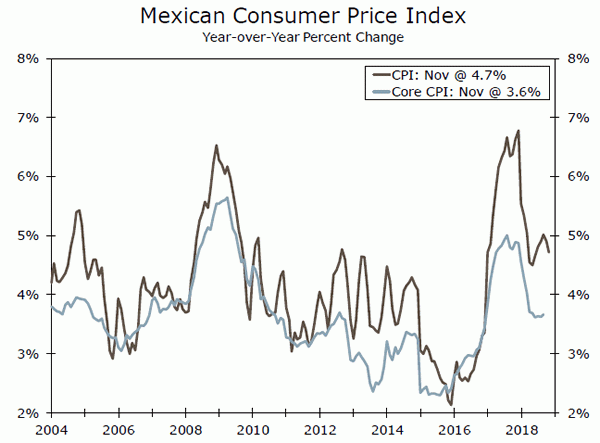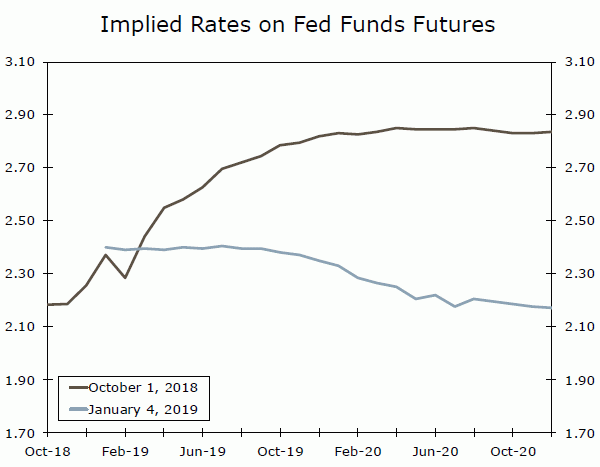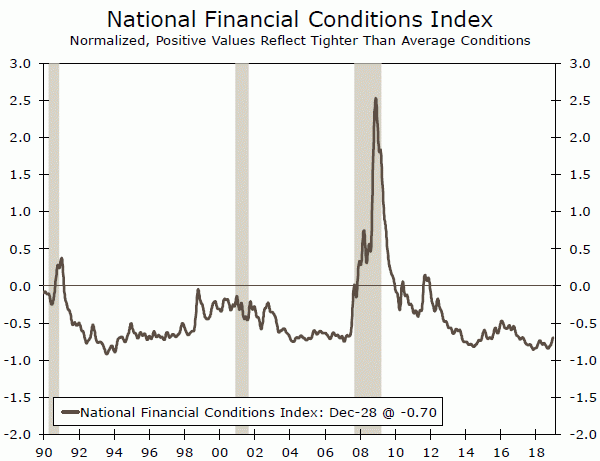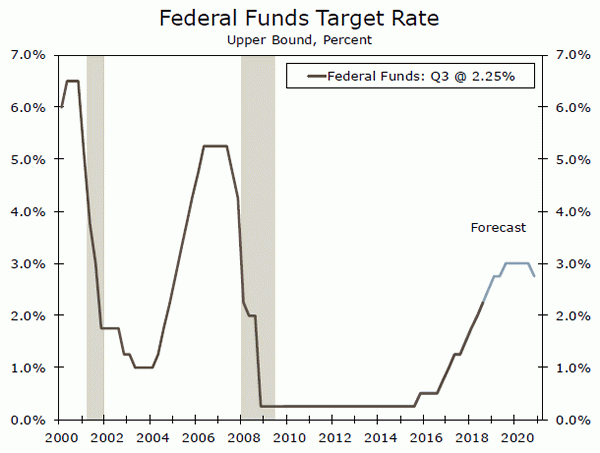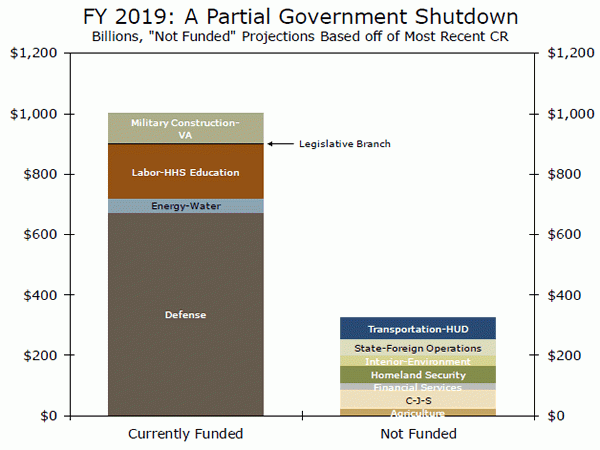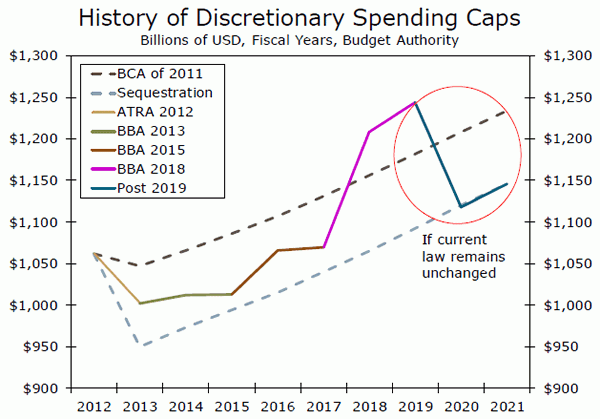U.S. Review
Conflicting Signals On Employment and Output
- Nonfarm employment jumped by 312,000 in December, the largest gain since February. Data for the prior months were also revised higher. Gains were broad-based, and there was also a huge increase in the labor force, which explains why the unemployment rate rose 0.2 percentage points to 3.9%.
- The stronger job report is a sharp contrast to December’s weaker ISM manufacturing survey, which tumbled 5.2 points. That marks the largest one-month drop in more than a decade. Moreover, the forward-looking new orders index plunged 11 points, signaling the factory sector is likely to slow further in coming months.
It’s Not Just The Financial Markets Losing Steam
The sell-off in the stock market that began in early October appears to be more of a harbinger of tougher economic times than a simple overdue correction. The production side of the economy has slowed considerably, pulling down commodity prices and business confidence. December’s ISM Manufacturing survey tumbled 5.2 points to 54.1, the largest one-month drop in more than a decade. The drop in the headline index was driven primarily by an 11-point plunge in the new orders component, which tumbled to just 51.1. Order backlogs also declined. The decline in these two leading components suggests that output and manufacturing employment are both likely to slow further in coming months.
While manufacturing accounts for just 12% of the economy, it still accounts for the bulk of the quarterly swings in real GDP and its performance is closely watched by policymakers. The latest slide is particularly disconcerting in that it is not linked to any single industry or region, as we saw in the middle of the decade, but is rather sharp and broad-based like we have typically seen prior to the onset of a recession. The top chart shows a comparison of the ISM manufacturing survey and the average of the regional manufacturing surveys from the New York, Philadelphia, Richmond and Dallas Federal Reserve Banks.
The apparent slide in the factory sector was not evident in the employment data. Nonfarm employment surged by 312,000 in December and data for the prior two months were revised up by 58,000 jobs. Strength was broad-based, which lends credence to the headline number. Moreover, manufacturing payrolls added 32,000 jobs in December and gains were broad-based.
We suspect the December data contained some catch-up elements. This past fall’s hurricanes hit during the September and October survey weeks, and the California wildfires and unusually wet weather along much of the East Coast depressed job growth the following month. After not changing in November, construction employment rose by 32,000 in December, with most of the increase coming in heavy and civil engineering construction, likely reflecting highway work. All of that gain, however, was due to a smaller than usual non-seasonally adjusted drop in jobs. But even after taking this into account, the stronger jobs figures and the 0.4% rise in average hourly earnings should alleviate any concerns about a more troublesome slowdown.
Consumer spending also appears to be holding up well. Early reports on the holiday shopping season suggest consumers splurged a bit. Motor vehicle sales also came in strong, with the Ward’s measure showing sales at a 17.5 million vehicle pace in December. Lower gas prices helped boost spending in both areas.
Reconciling the weak ISM report and strong employment report puts policymakers in a bit of a quandary. The ISM report is more of a leading indicator, while the jobs figures tend to be more backward looking. The Fed puts a great deal of stock into the ISM data and a further weakening below 50 in the next few months would provide ample support for folks inside and outside the Fed that are calling for a pause in the Fed’s rate hikes.
U.S. Outlook
ISM Non-Manufacturing • Monday
Economic activity has been exceptionally strong according to the ISM non-manufacturing index, which has come in above 60 for three consecutive months. We expect to see the index end the year on a softer note, however. Lower oil prices are likely to hit respondents in the mining industry, while comments from recent reports indicated some concerns over tariffs. In contrast to the ISM non-manufacturing index, regional PMIs for the service sector as well as the Markit services index have rolled over the past few months.
A sharp miss to the downside would generate more cause for concern about a slowdown in the economy given that the non-manufacturing index represents nearly 90% of U.S. output. Another elevated print, however, would suggests that the economy’s momentum remained solid heading into the new year.
Previous: 60.7 Wells Fargo: 58.4 Consensus: 59.5
NFIB Small Business Optimism • Tuesday
Like the ISM indices, the NFIB’s Small Business Optimism Index was fairly buoyant in 2018. The index has lost some ground the past couple months, however, as expectations for the economy and sales have moderated. With the stock market having tumbled over December, a further pullback in sentiment is expected.
While expectations for sales and profits have come down a bit, the NFIB survey continues to suggest a tight labor market. The most commonly cited challenge of small firms has been finding qualified labor, while the share of firms reporting they have at least one job hard to fill is already reported to have risen in December to a recordhigh of 39. At the same time, the share of firms raising compensation hovers near all-time highs, signaling to the FOMC further upward pressure on wages and, potentially, inflation.
Previous: 104.8 Consensus: 103.5
Consumer Price Index • Friday
Falling gasoline prices in November left the consumer price index unchanged. With gasoline prices declining further last month, we expect the CPI slipped 0.1% in December. We also anticipate a softer reading for core inflation (+0.1%) to account for some payback after a rare back-to-back increase in core goods prices and an above-trend gain in shelter costs. That said, the overall trend in core inflation is expected to remain firm.
Given that the FOMC focuses on core inflation in its near-term policy deliberations, a downside miss on the headline is unlikely to ring alarm bells if driven by drops in energy and/or food. An increase in core CPI of 0.1-0.2% would be consistent with the recent trend. A noticeably weaker print for the core index would suggest that inflation is not a pressing threat, while an upside surprise would support the FOMC’s recent plans to raise rates.
Previous: 0.0% Wells Fargo: -0.1% Consensus: -0.1% (Month-over-Month)
Global Review
Fears of Global Economic Slowdown Linger
- Weak Chinese PMI data earlier in the week weighed on global sentiment, and saw Chinese authorities announce a further cut in the reserve requirement ratio for banks, effectively increasing liquidity in the banking system.
- Other economic data from international economies were somewhat mixed, including a subdued Canadian jobs report, soft Eurozone inflation figures and a rebound in U.K. PMIs. Politics remain in focus as well, as the Italy-E.U. budget spat was largely resolved but uncertainty remains over the next steps for the Brexit process and the ongoing U.S.-China trade war.
Fears of Global Economic Slowdown Linger
Economic news on the global front was somewhat mixed in the first week of the new year, with concerns lingering over prospects for global economic growth. China garnered attention as the official and Caixin manufacturing PMIs fell into contraction territory (i.e., below 50), reigniting concerns around a sharper slowdown in the world’s largest developing economy. Later in the week, China announced that it would reduce the reserve requirement ratio (RRR) for major banks 100 basis points to 13.50%, effectively increasing the amount of liquidity in the banking system. That announcement is likely at least partly a response to weak economic data, and comes after 250 basis points worth of RRR cuts in 2018. On a more positive note, the official and Caixin services PMIs climbed higher in December and remain well above the 50-line demarcating expansion and contraction. Meanwhile, there appears to be a great deal of anticipation around upcoming U.S.-China trade talks scheduled to take place on January 7-8. As a reminder, if the two sides do not reach a formal trade deal by March 1, President Trump has threatened to raise the current 10% tariff on $200 billion worth of Chinese goods to 25%.
Economic data from the United Kingdom were a bit less downbeat, as the December manufacturing and services PMIs recovered to 54.2 and 51.2, respectively. Still, it is hard to get particularly optimistic regarding U.K. economic prospects as a resolution to the current Brexit uncertainty remains elusive. Little progress was made in lessening that Brexit uncertainty in recent weeks as parliaments in the United Kingdom and European Union were on holiday recess, while U.K. Prime Minister Theresa May is still targeting a vote on the current Brexit withdrawal deal for the week of January 14. Elsewhere, Canada’s December jobs report was generally soft in tone—9,300 jobs were added over the month, but mostly in part-time industries, while the unemployment rate stayed at 5.6% and wage growth remained low at 1.5% year-overyear. The Bank of Canada already shifted toward a more dovish stance at its meeting in mid-December, and is likely to remain on hold at its upcoming policy announcement next week.
On a more positive note, Italian parliament approved a final budget proposal for 2019, settling on a deficit target of 2.04% of GDP for this year after a series of revisions recommended by the European Commission. The key question now for the Italian government will be how to allocate the limited stimulus to its various campaign promises, and moreover whether the government will actually be able to achieve its narrower deficit target. European data were limited this week—a slowing in December Eurozone CPI inflation to 1.6% year-over-year garnered some attention, but largely confirmed the narrative that ECB rate hikes are a long way off. Finally, Brazilian President Jair Bolsonaro took office on January 1, and is expected to detail his reform agenda in the coming days and weeks. Arguably at the top of the list, at least from an economic perspective, is reforming Brazil’s pension system, a key issue that has hindered consolidation in Brazil’s budget deficit and which is likely to pose an increasingly significant threat to the country’s finances unless addressed.
Global Outlook
Eurozone Retail Sales • Monday
2018 was a challenging year for the Eurozone economy, marked by slowing growth and worsening sentiment. The retail sector was no exception, as total sales growth slowed to roughly 1.5% year-over-year toward the end of 2018 from a run rate of above 2% for most of 2017. While a change in auto emissions rules led to some volatility in the overall series, sales excluding motor vehicles have also softened in recent months.
The weakening in consumer confidence over the course of last year does not bode particularly well for retail sales in 2019, while the services sector PMI has also fallen markedly over the past year. However, firming wage growth in the Eurozone gives us confidence that retail sales should hold up reasonably well this year, while steady employment growth should also bode well for overall consumer spending in the region.
Previous: 0.3% Consensus: 0.2% (Month-over-Month)
Bank of Canada • Wednesday
The Bank of Canada (BoC) is likely to hold its overnight rate steady at 1.75% when it announces monetary policy next week. At its latest meeting in early December, the central bank sounded more cautious with regards to the domestic economic outlook, in part due to the ongoing weakness in oil prices. Moreover, it said there was “more room for non-inflationary growth,” a sign it likely felt less urgency to normalize interest rates. Amid that more dovish signaling, market pricing for future BoC rate hikes has fallen substantially in recent weeks.
Despite more dovish BoC language, we still think the central bank will hike rates further in 2019. Headline inflation has eased, but core inflation has held relatively steady near the BoC’s 2% target, while Canadian economic growth generally remains above potential. Next week’s policy decision could provide clues for when that next hike could be delivered.
Previous: 1.75% Wells Fargo: 1.75% Consensus: 1.75%
Mexico CPI • Wednesday
The Bank of Mexico raised its overnight rate 25 bps to 8.25% in late December, its fourth 25 bps rate hike of 2018. Those rate hikes coincided with another volatile year for the Mexican peso, which swung from gains to losses as markets considered Mexico’s economic and fiscal prospects under the leadership of new president Andres Manuel Lopez Obrador (AMLO). Amid all the volatility in the peso, Mexican CPI inflation was reasonably steady for most of last year, particularly when looking at the core figure. Accordingly, rate hikes from Mexico’s central bank appeared to be more defensive in nature, aimed at keeping inflation expectations anchored and limiting the pass-through from a weaker peso to higher inflation. Subsequent CPI readings will be key to watch for clues on whether the central bank will continue to raise interest rates, while any further signs of disruptive economic policies under AMLO’s leadership could also prompt a hawkish response from central bank policymakers.
Previous: 4.7% Consensus: 4.8% (Year-over-Year)
Point of View
Interest Rate Watch
Is the Fed Done Hiking Rates?
In early October, the U.S. economy was cruising along with strong growth momentum and with stock market indices sitting at or near all-time highs. Prices of fed funds futures contracts at that time indicated that investors expected the Federal Open Market Committee (FOMC) would raise rates 75 bps by the end of 2019 (top chart). Three months later, the economy has decelerated somewhat and financial markets have encountered a bout of volatility. Investors now expect that the FOMC will refrain from raising rates further, and that it will cut rates by 25 bps in 2020.
Has the high-water mark for the fed funds rate for this cycle been reached already? The sequential rate of real GDP growth has slowed from 4.2% in Q2-2018 to 3.4% in Q3 to our estimate of 2.2% in Q4. And the recent widening in credit spreads and the swoon in the stock market represent a tightening in financial conditions that we discussed in more detail in a recent report. Although financial conditions, as measured by the Chicago Fed’s National Financial Conditions Index, have tightened in recent weeks, they do not appear to be overly restrictive at present, at least not in a historic context (middle chart).
At its last policy meeting on December 19, the FOMC voted unanimously to raise rates 25 bps. Moreover, the FOMC’s “dot plot” indicates that most FOMC members thought that 50 bps of further rate hikes would be appropriate in 2019. But the events of the past few weeks cast some doubt on those expectations. Dallas Fed President Kaplan said this week that he believes the FOMC should pause until some of the uncertainties are resolved.
Our most recent forecast, which was compiled in early December, looks for two 25 bps rate hikes in 2019, first in March and again in September (bottom chart). But we readily acknowledge that the risks are skewed to a longer pause in the first half of the year than we thought just a month ago. We will be watching incoming data and making changes to our Fed call, as appropriate.
Credit Market Insights
Tighter Credit Conditions Ahead?
The end of 2018 saw a ramp up in financial market volatility, with the S&P 500 index falling over 10% in Q4. As discussed in our Interest Rate Watch section, we have examined the recent tightening in financial conditions and possible implications for monetary policy.
With these trends in mind, what does the recent tightening in financial conditions mean for broader credit availability? For starters, until recently, financial conditions have actually eased even as the FOMC has normalized monetary policy. This relationship is indicative of the performance of the broader economy. GDP growth remained solid in Q3, while consumers continue to enjoy rising wages and inflation that is largely anchored.
At the same time, loan growth remains positive, with consumer loans rising nearly 4.6% year-over-year in November. The most recent data from the Senior Loan Officer Opinion Survey echo the hard data and point to banks’ willingness to make consumer loans continuing to rise in Q3. The survey also noted that “banks reported little change in their credit standards and most terms across categories of consumer loans on balance.”
On net, although financial conditions have tightened as the cost of credit has steadily increased while the Fed has raised rates, overall credit availability still looks relatively robust for most consumers, while interest rates are also still low by historical norms.
Topic of the Week
D.C. Deadline Drama in 2019? Probably.
Congress and the President were unable to reach an agreement on all 2019 appropriation bills at the end of December, leading to a partial government shutdown that began on December 22 and has persisted into the new year. While government shutdown drama has mostly been avoided in recent years, the return of divided government means these topics could come back into focus in 2019. In a special report published this week, we analyze the economic impact of the shutdown and key issues to watch in Washington over the coming year.
Given that 75% of discretionary spending has already been appropriated and passed into law (top chart), we see the current shutdown having only a minimal negative impact on quarterly GDP growth of 0.1-0.2 percentage points at most, assuming the current impasse is resolved in the near future. But the shutdown is unlikely to be the only budget issue this year. The two-year budget deal passed in February 2018 that set top-line spending levels for FY 2018 and FY 2019 will no longer be in effect when FY 2020 begins on October 1 (bottom chart). This means that Congress will need to determine both the total amount of funds available for 2020 appropriations, as well as complete the actual appropriations process.
Adding to already-complex budget process, the debt ceiling will also be reinstated on March 2, meaning that the U.S. Treasury will be unable to issue additional debt to meet government spending needs beyond what is met by tax revenue. It would then need to use “extraordinary measures” to meet the daily cash flow needs of the federal government until Congress can agree on a new debt limit. Based on our analysis, we expect the “X date,” or the date by which the debt ceiling must be raised before the Treasury is unable to meet all of its obligations, to occur in mid-to-late summer, creating the potential for another budget showdown later this year.
In sum, with concerns swirling about global growth, monetary policy mistakes and other recession risks, a fiscal fumble from policymakers in Washington is another risk to the economic outlook as 2019 progresses.




